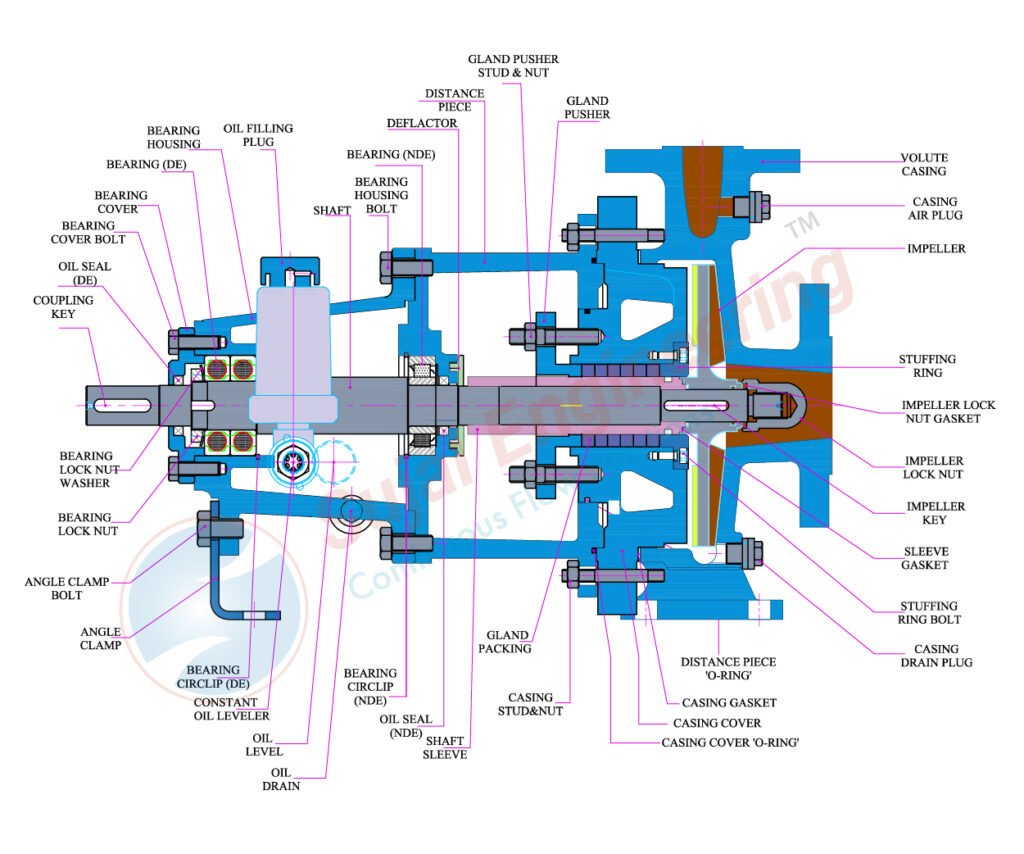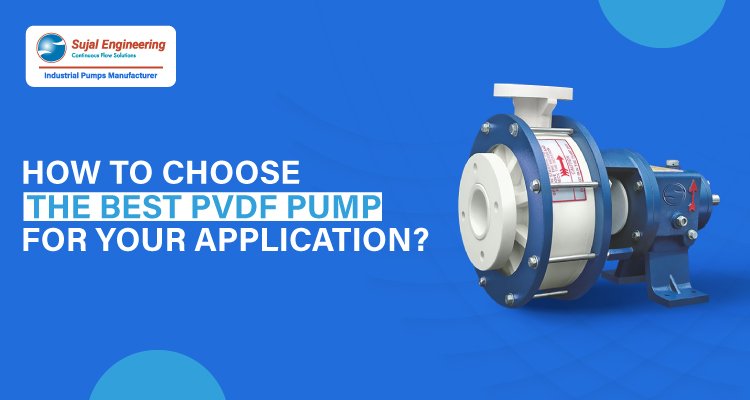Centrifugal Pumps: Components, Working, Types & Applications – A Detailed Guide

Introduction
Centrifugal pumps are one of the most popular pumps used in various industries for moving fluids from one place to another. These pumps work on the principle of converting mechanical energy from a motor into kinetic energy, used to drive the fluid through the pump and into the discharge pipe.
The reason why Centrifugal pumps are the first choice for numerous applications is their pumping efficiency, high flow rate, and durable design. There are different types of centrifugal pumps available for diverse applications.
When installing a pump, it is important to choose the right pump type, as it ensures that your pump systems operate for years without any interruption.
To select the right centrifugal pump, you must have complete knowledge of what a centrifugal pump is, its components, different types, working, and so on.
This blog will take a detailed look at Centrifugal Pumps and will give you an in-depth understanding of topics such as:
- Definition of Centrifugal Pumps
- Main Components Of Centrifugal Pumps
- Different Types Of Centrifugal Pumps
- Working Principle Of Centrifugal Pumps
- Benefits And applications Of Centrifugal Pumps
What Is A Centrifugal Pump?
A centrifugal pump is a rotary equipment that converts mechanical energy into kinetic energy through centrifugal force on the liquid. Further power generated from the electric motor drives the impeller of the pump, where fluids enter and exit due to centrifugal force from the pump impeller tip. The liquid then gets discharged to the volute casing.
In essence, a centrifugal pump is a machine used in industrial applications for transporting fluid from one location to another without causing any problems with leakage and heat transfer.
Different mechanical components of centrifugal pumps have their own functions and characteristics, which together make the smooth operation of pumps possible.
Let’s know about these significant components.
Key Components Of Centrifugal Pumps

Below are the basic components that every centrifugal pump has:
1. Shaft And Shaft Sleeve:
The first and central component is the centrifugal pump shaft, which is connected to the driving motor and pump impeller and ensures rotational movement. Positioned perfectly with ball bearing, the pump shaft is linked with the prime mover to receive the essential power.
Additionally, a shaft sleeve is employed in the centrifugal pump to prevent leakage and corrosion.
2. Impeller
The centrifugal pump impeller is a rotating component that consists of a series of curved vanes. Mounted on a shaft, it is enclosed in a watertight casing.
The centrifugal pump impeller is divided into three types.
A] Open Impeller:
It is mounted directly on the shaft. These impeller vanes have no walls making them weaker than closed valves, but quicker and easier to clean and repair.
B] Closed Impeller:
In closed impeller type, the impeller vanes are sandwiched between two front and back cover plates and are used to obtain pure water.
C] Semi-Open Impeller:
This type of impeller has a back-wall cover plate, which provides mechanical power to the van. It is widely used in medium-sized pumps to pump debris-loading fluid.
3. Casing
Pump casing is used to seal the pump to the atmosphere to prevent leakage. It is mainly an airtight passage surrounding the impeller designed to convert the kinetic energy into pressure energy to allow liquid to leave the casing and enter the delivery pipe.
The casing of the centrifugal pump has three types:
A] Volute Casing:
Surrounded by the pump impeller, the volute casing provides a gradual rise in the flow area, which decreases the water velocity and increases the pressure.
B] Vortex Casing:
A vortex casing is a casing where a circular chamber is provided between the casing and the impeller. This type of casing is used to increase the efficiency of the pump and reduce the formation of eddies.
C] Casing With Guide Blades
In this type of pump casing, there are blades around the impeller. These guide blades are designed to allow water passage through the guide vanes without shock and allow water to leave with pressure.
4. Delivery Pipe
A delivery pipe is a key component of a centrifugal pump, which has two ends, where one end is connected to the lower end of the pump outlet, and the other end delivers the liquid at a required height.
5. Suction Pipe with Foot Valve and Strainer
The suction pipe in the centrifugal pump has two ends; one is connected to the pump inlet, and the other is dipped into the liquid. Moreover, a foot valve and strainer are also fitted to prevent the entry of unwanted particles into the suction pipe.
How Does A Centrifugal Pump Work?
The first step in the operation of a centrifugal pump is generating mechanical power. This power is generated by an electric motor or engine and is provided to the pump impeller attached to the motor or engine through a shaft.
Next, when the pump impeller starts rotating, a vacuum starts forming inside the eye of the impeller, which allows liquid to enter the impeller’s eye in the axial direction.
As the fluid enters the impeller’s eye, it hits the impeller blades, which rotate the liquid radially and axially outward via centrifugal force.
The blades convert the liquid’s kinetic energy into its speed and increase the speed of the liquid. However, when the liquid enters the diffuser area, the diffuser slows down the liquid by decreasing its speed.
This is to convert liquid speed into pressure energy to discharge it through the pump outlet by increasing the pressure.
Types Of Centrifugal Pumps
There are different types of centrifugal pumps classified based on their numbers of impellers, casing type, fluid orientation, and pump position.
1. Based on the number of impellers
- Single stage impeller
- Multistage impeller
2. Based on the type of casing
- Turbine pump
- Volute pump
3. Based on the fluid orientation
- Radial flow pump
- Axial flow pump
- Mixed flow pump
4. Based on the pump position
- Horizontal pump
- Vertical pump
- Submersible pump
Advantages of Centrifugal Pump
The advantages of centrifugal pumps include:
- Reduced friction
- Resistance to corrosion
- Energy efficiency
- Smooth liquid flow
- Durable in extreme conditions
- Low routine maintenance
- Wide variety in types and sizes
- Provides thermal barrier
- Eliminates the risk of a leakage
Centrifugal Pumps Applications
- Hot and Cold Water Circulation
- Cooling Towers Installation
- Paper Industries
- Thermic Fluid Boiler
- Heat Exchanger
- Chemical Industries
- Sugar Plants
- Textile Industries
- Ceramic Industries
- Solvent Transfer
- Food Industries
- Laminate Industries
- Marine/Ports
- Automobile Industries
- Seawater and in many more industries and applications
Ending Note
Centrifugal pumps offer the required efficiency and reliability in various industrial applications. From their ability to pump corrosive and abrasive fluids to saving energy for optimal performance, centrifugal pumps are the most trusted choice for pumping liquids.
Furthermore, to ensure safe pumping operation, it is important to install the best quality centrifugal pumps. Sujal Engineering is a popular centrifugal pump manufacturer in India. We manufacture a wide range of industrial pumps according to the industry’s needs to deliver the right solution that overcomes industrial challenges.
Looking for a centrifugal pump for your industrial needs?





